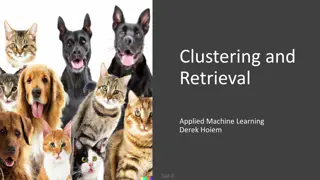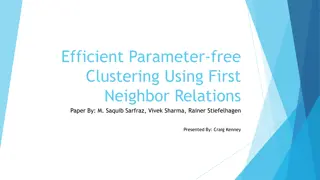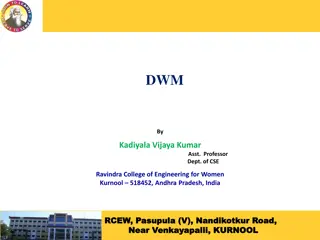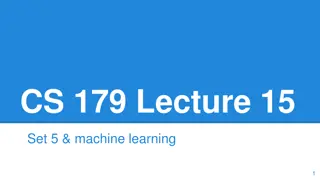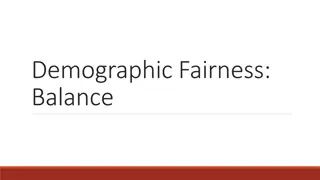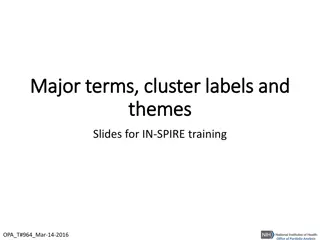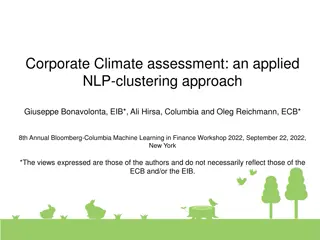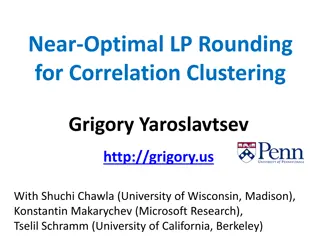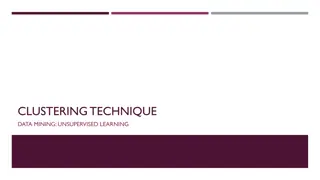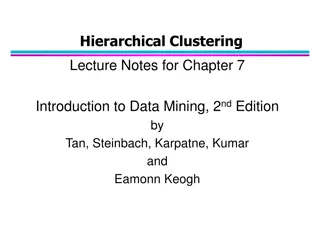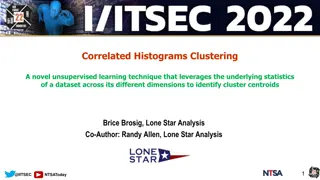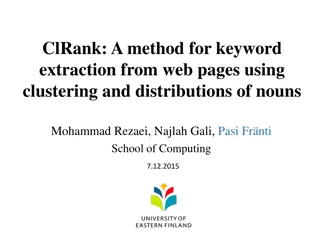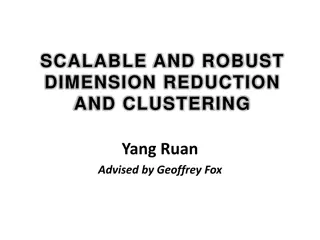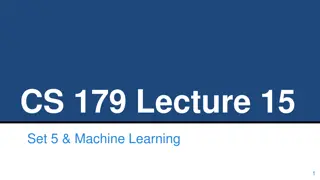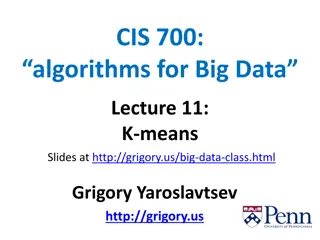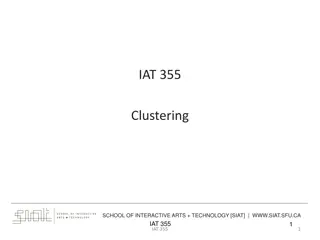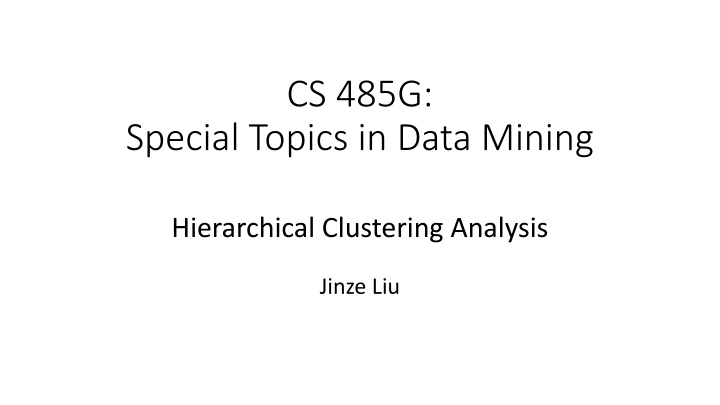
Hierarchical Clustering Analysis for Data Mining
Explore hierarchical clustering analysis in data mining including agglomerative and divisive methods, dendrogram visualization, distance measures, and cluster merging techniques. Learn how to group data objects into a tree of clusters for effective data analysis and insights.
Download Presentation

Please find below an Image/Link to download the presentation.
The content on the website is provided AS IS for your information and personal use only. It may not be sold, licensed, or shared on other websites without obtaining consent from the author. If you encounter any issues during the download, it is possible that the publisher has removed the file from their server.
You are allowed to download the files provided on this website for personal or commercial use, subject to the condition that they are used lawfully. All files are the property of their respective owners.
The content on the website is provided AS IS for your information and personal use only. It may not be sold, licensed, or shared on other websites without obtaining consent from the author.
E N D
Presentation Transcript
CS 485G: Special Topics in Data Mining Hierarchical Clustering Analysis Jinze Liu
Outline What is clustering Partitioning methods Hierarchical methods Density-based methods Grid-based methods Model-based clustering methods Outlier analysis
Hierarchical Clustering Group data objects into a tree of clusters Step 1 Step 2 Step 3 Step 4 Step 0 agglomerative (AGNES) a a b b c a b c d e c d e d e d e divisive (DIANA) Step 3 Step 2 Step 1 Step 0 Step 4
AGNES (Agglomerative Nesting) Initially, each object is a cluster Step-by-step cluster merging, until all objects form a cluster Single-link approach Each cluster is represented by all of the objects in the cluster The similarity between two clusters is measured by the similarity of the closest pair of data points belonging to different clusters
Dendrogram Show how to merge clusters hierarchically Decompose data objects into a multi-level nested partitioning (a tree of clusters) A clustering of the data objects: cutting the dendrogram at the desired level Each connected component forms a cluster
DIANA (DIvisive ANAlysis) Initially, all objects are in one cluster Step-by-step splitting clusters until each cluster contains only one object 10 10 10 9 9 9 8 8 8 7 7 7 6 6 6 5 5 5 4 4 4 3 3 3 2 2 2 1 1 1 0 0 0 0 1 2 3 4 5 6 7 8 9 10 0 1 2 3 4 5 6 7 8 9 10 0 1 2 3 4 5 6 7 8 9 10
Distance Measures Minimum distance Maximum distance Mean distance Average distance = C ( , ) min , ( , ) d C d p q min i j p C max , q C i j = C ( , ) ( , ) d C d p q max i j d p C ( q C , i j = C ( , ) ) d C m m mean i j i j 1 i C p = C ( , ) ( , ) d C d p q avg i j n n q C i j j m: mean for a cluster C: a cluster n: the number of objects in a cluster
Challenges of Hierarchical Clustering Methods Hard to choose merge/split points Never undo merging/splitting Merging/splitting decisions are critical Do not scale well: O(n3) What is the bottleneck when the data cannot fit in memory?
Comparison Partitioning Clustering Hierarchical Clustering Time Complexity O(n) O(n2) or O(n3) Pros Easy to use and Relatively efficient Outputs a dendrogram that is desired in many applications. Cons Sensitive to initialization; bad initialization might lead to bad results. Need to store all data in memory. higher time complexity; Need to store all data in memory. April 13, 2025 12
Other Alternatives Integrating hierarchical clustering with other techniques BIRCH, CURE, CHAMELEON, ROCK
BIRCH Balanced Iterative Reducing and Clustering using Hierarchies
Introduction to BIRCH Designed for very large data sets Time and memory are limited Incremental and dynamic clustering of incoming objects Only one scan of data is necessary Does not need the whole data set in advance Two key phases: Scans the database to build an in-memory tree Applies clustering algorithm to cluster the leaf nodes April 13, 2025 15
BIRCH: The Idea by example BIRCH: The Idea by example Clustering Process (build a tree) Data Objects 1 Leaf node 2 3 1 2 4 5 Cluster1 6 If cluster 1 becomes too large (not compact) by adding object 2, then split the cluster
BIRCH: The Idea by example BIRCH: The Idea by example Clustering Process (build a tree) Data Objects 1 entry 1 entry 2 Leaf node 2 3 1 2 4 5 Cluster2 Cluster1 6 Leaf node with two entries
BIRCH: The Idea by example BIRCH: The Idea by example Clustering Process (build a tree) Data Objects 1 entry 1 entry 2 Leaf node 2 3 1 2 3 4 5 Cluster2 Cluster1 6 entry1 is the closest to object 3 If cluster 1 becomes too large by adding object 3, then split the cluster
BIRCH: The Idea by example BIRCH: The Idea by example Clustering Process (build a tree) Data Objects 1 entry 1 entry 3 entry 2 Leaf node 2 3 1 2 3 4 5 Cluster2 Cluster3 Cluster1 6 Leaf node with three entries
BIRCH: The Idea by example BIRCH: The Idea by example Clustering Process (build a tree) Data Objects 1 entry 1 entry 2 entry 3 Leaf node 2 3 4 1 2 3 4 5 Cluster2 Cluster2 Cluster3 Cluster1 6 entry3 is the closest to object 4 Cluster 2 remains compact when adding object 4 then add object 4 to cluster 2
BIRCH: The Idea by example BIRCH: The Idea by example Clustering Process (build a tree) Data Objects 1 entry 1 entry 2 entry 3 Leaf node 2 3 5 4 1 2 3 4 5 Cluster2 Cluster3 Cluster1 6 entry2 is the closest to object 5 Cluster 3 becomes too large by adding object 5 then split cluster 3? BUT there is a limit to the number of entries a node can have Thus, split the node
BIRCH: The Idea by example BIRCH: The Idea by example Clustering Process (build a tree) Data Objects Non-Leaf node 1 entry 1 entry 2 2 3 4 entry 1.1 entry 2.1 entry 1.2 entry 2.2 Leaf node Leaf node 5 6 5 4 1 2 3 Cluster2 Cluster4 Cluster3 Cluster1
BIRCH: The Idea by example BIRCH: The Idea by example Clustering Process (build a tree) Data Objects Non-Leaf node 1 entry 1 entry 2 2 3 4 entry 1.1 entry 2.1 entry 1.2 entry 2.2 Leaf node Leaf node 5 6 5 4 1 2 3 6 Cluster2 Cluster3 Cluster3 Cluster4 Cluster1 entry1.2 is the closest to object 6 Cluster 3 remains compact when adding object 6 then add object 6 to cluster 3
BIRCH: Key Components BIRCH: Key Components Clustering Feature (CF) Summary of the statistics for a given cluster: the 0-th, 1st and 2nd moments of the cluster from the statistical point of view Used to compute centroids, and measures the compactness and distance of clusters CF-Tree height-balanced tree two parameters: number of entries in each node The diameter of all entries in a leaf node Leaf nodes are connected via prev and next pointers
Clustering Feature Clustering Feature Clustering Feature (CF):CF = (N, LS, SS) N: Number of data points = N X LS: linear sum of N points: i 1 i = N 2 X SS: square sum of N points: i 1 i CF3=CF1+CF2= 3+3, (9+35, 10+36), (29+417 , 38+440) = 6, (44,46), (446 ,478) Cluster3 Cluster 1 (2,5) (3,2) (4,3) Cluster 2 CF2= 3, (35,36), (417 ,440) CF1= 3, (2+3+4 , 5+2+3), (22+32+42 , 52+22+32) = 3, (9,10), (29 ,38)
Some Characteristics of CFVs Two CFVs can be aggregated. Given CF1=(N1, LS1, SS1), CF2 = (N2, LS2, SS2), If combined into one cluster, CF=(N1+N2, LS1+LS2, SS1+SS2). The centroid and radius can both be computed from CF. centroid is the center of the cluster radius is the average distance between an object and the centroid. = = 0 R N i x 1 1 N = N i x x x = 2 ( 0) i 1 i N X0 = LS/N R = 1/N * sqrt(N*SS-LS^2)
Clustering Feature Clustering feature: Summarize the statistics for a subcluster the 0th, 1st and 2nd moments of the subcluster Register crucial measurements for computing cluster and utilize storage efficiently
CF-tree in BIRCH A CF tree: a height-balanced tree storing the clustering features for a hierarchical clustering A nonleaf node in a tree has descendants or children The nonleaf nodes store sums of the CFs of children
CF Tree CF1 child1 CF2 child2 CF3 child3 CF6 child6 B = 7 L = 6 Root Non-leaf node CF1 CF2 CF3 CF5 child1 child2 child3 child5 Leaf node Leaf node prev next prev next CF1CF2 CF6 CF1CF2 CF4
Parameters of A CF-tree Branching factor: the maximum number of children Threshold: max diameter of sub-clusters stored at the leaf nodes
CF Tree Insertion Identifying the appropriate leaf: recursively descending the CF tree and choosing the closest child node according to a chosen distance metric Modifying the leaf: test whether the leaf can absorb the node without violating the threshold. If there is no room, split the node Modifying the path: update CF information up the path. 32 of 28
Example of the BIRCH Algorithm Example of the BIRCH Algorithm New subcluster sc4sc5 sc8 sc6 sc7 LN3 sc3 LN2 sc1 sc2 Root LN2 LN3 LN1 LN1 sc8 sc1sc2sc3sc4sc5sc6 sc7 33 of 28
Insertion Operation in BIRCH Insertion Operation in BIRCH If the branching factor of a leaf node can not exceed 3, then LN1 is split sc4sc5 sc1 sc3 sc6 sc2 sc7 sc8 LN2 LN1 LN3 Root LN2 LN3 LN1 LN1 LN1 sc8 sc1sc2sc3sc4sc5sc6 sc7
Insertion Operation in BIRCH Insertion Operation in BIRCH If the branching factor of a non-leaf node can not exceed 3, then the root is split and the height of the CF Tree increases by one sc3 sc6 sc1 sc4 Root sc2 sc7 sc5 NLN1 sc8 LN3 LN2 NLN2 LN1 LN1 LN1 LN1 LN2 LN3 sc8 sc1 sc2sc3sc4sc5 sc7 sc6 19 of 28
Birch Clustering Algorithm (1) Phase 1: Scan all data and build an initial in-memory CF tree. Phase 2: condense into desirable length by building a smaller CF tree. Phase 3: Global clustering Phase 4: Cluster refining this is optional, and requires more passes over the data to refine the results 20 of 28
Pros & Cons of BIRCH Linear scalability Good clustering with a single scan Quality can be further improved by a few additional scans Can handle only numeric data Sensitive to the order of the data records
3.3.4 ROCK: for Categorical Data 3.3.4 ROCK: for Categorical Data Experiments show that distance functions do not lead to high quality clusters when clustering categorical data Most clustering techniques assess the similarity between points to create clusters At each step, points that are similar are merged into a single cluster Localized approach prone to errors ROCK: used links instead of distances
Example: Compute Jaccard Coefficient Example: Compute Jaccard Coefficient Transaction items: a,b,c,d,e,f,g Two clusters of transactions Cluster1. <a, b, c, d, e> {a, b, c} {a, b, d} {a, b, e} {a, c, d} {a, c, e} {a, d, e} {b, c, d} {b, c, e} {b, d, e} {c, d, e} Compute Jaccard coefficient between transactions | | T T i j ( , ) sim T T i j | | T T i j Sim({a,b,c},{b,d,e})=1/5=0.2 Jaccard coefficient between transactions of Cluster1 ranges from 0.2 to 0.5 Jaccard coefficient between transactions belonging to different clusters can also reach 0.5 Cluster2. <a, b, f, g> {a, b, f} {a, b, g} {a, f, g} {b, f, g} Sim({a,b,c},{a,b,f})=2/4=0.5
Example: Using Links Example: Using Links Two clusters of transactions Cluster1. <a, b, c, d, e> {a, b, c} {a, b, d} {a, b, e} {a, c, d} {a, c, e} {a, d, e} {b, c, d} {b, c, e} {b, d, e} {c, d, e} Transaction items: a,b,c,d,e,f,g The number of links between Ti and Tj is the number of common neighbors Ti and Tj are neighbors if Sim(Ti,Tj)> Consider =0.5 Link({a,b,f}, {a,b,g}) = 5 (common neighbors) Cluster2. <a, b, f, g> {a, b, f} {a, b, g} {a, f, g} {b, f, g} Link({a,b,f},{a,b,c})=3 (common neighbors) Link is a better measure than Jaccard coefficient
ROCK ROCK ROCK: Robust Clustering using linKs Major Ideas Use links to measure similarity/proximity Not distance-based Computational complexity ma: average number of neighbors mm: maximum number of neighbors n: number of objects + + O n ( log ) 2 2 nm m n n m a Algorithm Sampling-based clustering Draw random sample Cluster with links Label data in disk
Drawbacks of Square Error Based Methods One representative per cluster Good only for convex shaped having similar size and density A number of clusters parameter k Good only if k can be reasonably estimated
Drawback of Distance-based Methods Hard to find clusters with irregular shapes Hard to specify the number of clusters Heuristic: a cluster must be dense
Directly Density Reachable p MinPts = 3 Eps = 1 cm Parameters Eps: Maximum radius of the neighborhood MinPts: Minimum number of points in an Eps-neighborhood of that point NEps(p): {q | dist(p,q) Eps} Core object p: |Neps(p)| MinPts Point q directly density-reachable from p iff q Neps(p) and p is a core object q
Density-Based Clustering: Background (II) p p1 Density-reachable Directly density reachable p1 p2, p2 p3, , pn-1 pn pn density- reachable from p1 Density-connected Points p, q are density-reachable from o p and q are density-connected q p q o
DBSCAN A cluster: a maximal set of density-connected points Discover clusters of arbitrary shape in spatial databases with noise Outlier Border Eps = 1cm Core MinPts = 5
DBSCAN: the Algorithm Arbitrary select a point p Retrieve all points density-reachable from p wrt Eps and MinPts If p is a core point, a cluster is formed If p is a border point, no points are density-reachable from p and DBSCAN visits the next point of the database Continue the process until all of the points have been processed
Problems of DBSCAN Different clusters may have very different densities Clusters may be in hierarchies

